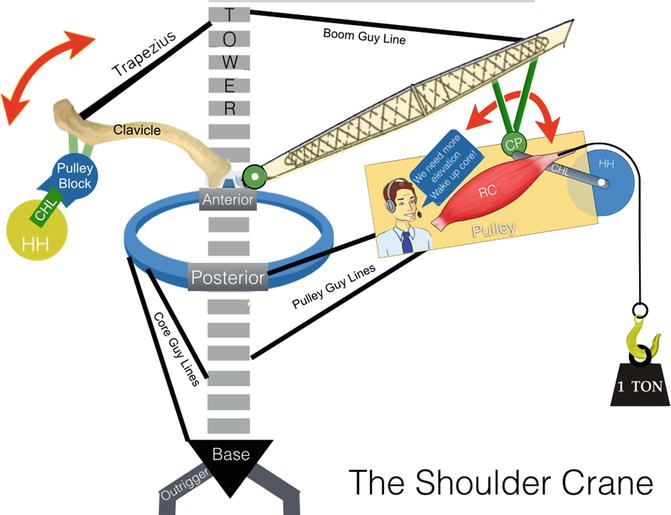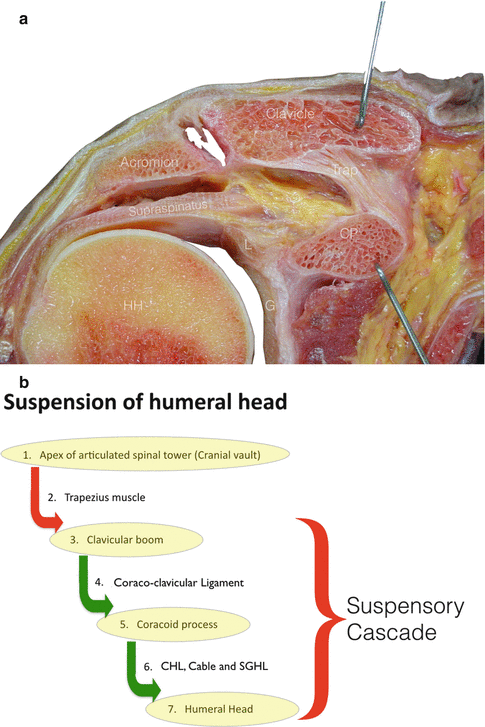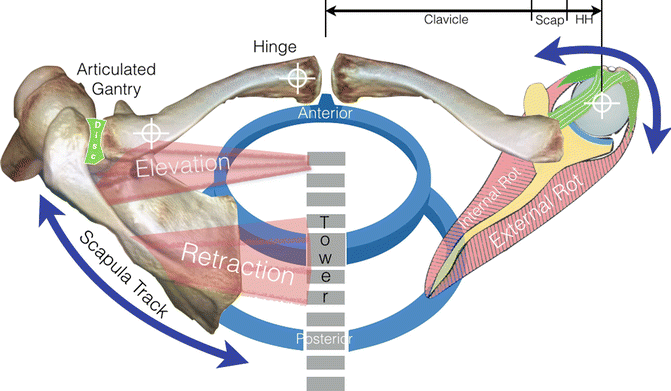Fig. 39.1
Evolution of the shoulder girdle . (a) Reptiles have a sprawling posture with the forces directed medially. (b) In terrestrial mammals the limbs are brought under the body, and the forces are directed ventrally. Note the extensive muscle sling that stabilises the scapula and shoulder girdle. (c) Running quadrupeds have a forelimb that swings like a pendulum, and but do not have a clavicle which would restrict motion. (d) The human shoulder can swing as a pendulum and also circumduct. (a, b Modified with permission from Kardong [2]; c, d modified with permission from Professor David Sonnabend)
There are significant biomechanical changes in the bipedal shoulder, which hangs from the axial skeleton but has the ability to elevate the humerus and the arm. The biped’s shoulder girdle is required to function in compression but also in tension and shear with shoulder elevation and rotation on a daily basis.
39.1.3 Acromion and Deltoid
The acromion is much larger in humans as it serves as the main attachment for the deltoid, and by increasing its size, it effectively lateralises the deltoid. The deltoid is the muscle that has enlarged the most with evolution , indicating the importance of the deltoid to shoulder function in humans. With a larger deltoid, the tensile forces on the acromion have increased, and the coraco-acromial ligament has evolved to transfer tension from the acromion to the coracoid process.
39.1.4 Rotator Cuff
The supraspinatus remains virtually unchanged with evolution . However, in humans, the infraspinatus is larger and has a more oblique vector making it a strong head depressor in addition to being an external rotator. In most animals, the rotator cuffs are separate muscles that attach to the humeral neck. However, in orthograde animals, there is a common rotator cuff tendon insertion [5]. This provides superior dynamic humeral head stability and humeral rotation in various positions of abduction and flexion.
39.2 The “Shoulder Crane”
The mechanical workings of the arm are analogous to a crane (Fig. 39.2). It has many working parts, which enable the arm to be elevated, so that functional above-head activities can be performed.


Fig. 39.2
The shoulder crane. (a) The crane is built on the pelvic base with legs for outriggers to provide stability and mobility. There is an articulated spinal tower with a thoracic platform on which the crane is housed. The clavicular boom articulates with the anterior platform, at the sternoclavicular joint and is elevated by the trapezius from the posterior tower. (b) The “suspensory cascade” extends from the outer clavicle to the humeral head and includes the clavicle/coraco-clavicular ligaments/coracoid process /coraco-humeral ligament /humeral head. (c) The scapula is a pulley, strategically positioned in the middle of the cascade of suspension, between the two ligamentous complexes. It swivels on the coraco-clavicular ligaments, to allow the scapula to accommodate to the shape of the “scapular track” and the position of the humeral head. (d) The scapula position is controlled by the multiple powerful peri-scapular muscles, that control the orientation of the glenoid and scapular body, for shoulder stability and power (Copyright Dr. Gregory Bain)
39.2.1 Base, Outrigger and Spinal Tower
The base (pelvis) and its outriggers (legs) provide stability for the entire mechanism. The articulated spinal tower (axial skeleton) extends from the pelvic base to the skull.
39.2.2 Elevated Thoracic Platform
The thoracic cage is an elevated platform midway up the axial tower. On top of this platform, the entire upper limb is secured and mobilised.
The platform and articulated tower are stabilised by the “core” muscles, which control and stabilise the relative position of the platform and the axial skeleton. As outriggers, the base and tower are all articulated, making core muscular control vitally important for any upper limb activity. We all initially focus on the shoulder musculature when assessing the shoulder, but the core muscles provide the stability on which the entire thorax and upper limb must counterbalance to perform functional activities.
39.2.3 Clavicular Boom
The clavicle is the boom (or jib) of the crane, which elevates and lateralises the point of suspension away from its hinge point. The hinge is the sternoclavicular joint at the anterior aspect of the elevated platform. There is a shock absorber (articular disc) at each end of the clavicle.
39.2.4 Cascade of Suspension
The clavicular boom is elevated by the trapezius muscle (“boom guy line” muscle), which originates from the cranium and the cervical spine. Therefore, the apex of suspension is well above the thoracic platform, at the top of the spinal tower. From the apex of the tower (cranium) to the humerus, there is a cascade of osseous and intervening suspensory structures. For each articulation, there is a set of “boom guy line” muscles, which provide dynamic control of the articulation. The coracoid is suspended from the lateral aspect of the clavicular boom by the coraco-clavicular ligaments, and in turn, the coraco-humeral ligament suspends the humerus from the coracoid.
39.2.5 Suspension of the Scapular Pulley
The coraco-clavicular ligaments insert into the base of the coracoid process and thereby suspend the scapula. They form part of the superior suspensory complex of the shoulder [6]. Disruption of this suspensory ring produces AC joint instability. It is interesting to note that the conoid ligament is the suspensory ligament and attaches to a prominent tubercle at the posterior angle of the clavicle. With clavicle rotation, the ligament shortens and lengthens by wrapping around the clavicle like the biceps tendon wraps around the proximal radius. The trapezoid is the lateralisation ligament of the scapula. Its chief function is to prevent medial displacement of the scapula relative to the clavicle (Fig. 39.3a). The scapula rotates around these two ligaments, with the AC joint capsule restraining anterior and posterior translation of the scapula.


Fig. 39.3
(a) Coraco-clavicular ligaments. The clavicular boom suspends and lateralises the scapula. The conoid ligament suspends the scapula and the trapezoid ligament restrains medialisation of the scapula. The scapula swivels on the coraco-clavicular ligaments. (b) Suspension of the humeral head and arm commences. From the clavicle, the “cascade of suspension” passes down to the humeral head (Image courtesy Professor Emilio Calvo)
39.2.6 Scapular Pulley
A pulley is a wheel designed to support movement and change direction along its circumference. The scapula is a pulley strategically suspended in the middle of the “suspensory cascade” between the clavicle and humerus (Fig. 39.3b). The scapular pulley swivels on the coraco-clavicular ligaments, below the lateral clavicular boom, to change the direction of the rotator cuff alignment to optimise shoulder function.
The scapular body provides a wide surface area for muscle attachments. The multiple powerful peri-scapular muscles span from the spinal tower and the thoracic platform. These peri-scapular muscles control scapular rotation and translation across the thoracic cage. We refer to the area of the thoracic cage on which the scapula traverses as the “scapular track”. The rotator cuff muscles control the humeral head across the “glenoid track”. The scapula is essentially a sesamoid bone positioned between the peri-scapular muscles that control the scapula and the rotator cuff, which controls the humeral head. These two major groups of muscles work together to position the humerus in space.
39.2.7 Scapular Triangle and Scapular Track
The scapula is stabilised and mobilised by a functional triangle (Fig. 39.4). The sides and angles of the triangle consist of


Fig. 39.4
Shoulder gantry (Left). The gantry is a scaffold over the top of the glenohumeral joint. It is composed of the clavicle, coracoid, CAL, acromion and scapular spine. The trapezius muscle (posterior) elevates the gantry, hinging on the sternoclavicular joint (anterior-medial). The gantry swivels at the coraco-clavicular ligaments, which allows the peri-scapular muscles to change scapula orientation. With these restraints, the scapula follows the “scapular track”. The AC joint fibrocartilaginous disc buffers the compressive forces and the coraco-clavicular ligaments resist the tensile forces. Shoulder triangle (Right). The triangular configuration of the shoulder girdle, thoracic cage, clavicular boom and scapula . The medial side is the elevated thoracic platform. The anterior side is the clavicular boom, which elevates and maintains the lateral position of the scapula. The lateral angle of the triangle is the coraco-clavicular ligaments, from which the scapula is suspended and swivels. The posterior side is the triangle is the scapular body and the peri-scapular muscles, which mobilise the scapula. Note that the centre of rotation of the humeral head is lateralised by this triangle, but also the width of the pulley block and the radius of the humeral head. The rotator cuff insertion is lateral to the centre of rotation of the humeral head, making it an important rotator. Note how the peri-scapular muscles power the scapula, and the rotator cuff controls the humeral head (Copyright Dr. Gregory Bain)
Medial side – The fixed thoracic platform.
Anterior angle – The sterno-clavicular hinge joint.
Anterior side – The clavicular boom elevates and lateralises the scapular pulley.
Lateral angle – The coraco-clavicular ligaments suspend and swivel the scapula.
Posterior side – The scapula and its peri-scapular muscles, which power and dynamically stabilise the scapula.
Posterior angle – The peri-scapular muscles’ insertions into the thoracic cage are a fixation point for the muscles.
Note that the three sides and three corners of the triangle all have different functions. The position of the scapula is defined by the angle of elevation of the sternoclavicular joint, the length of the clavicular boom and the tension in the various peri-scapular muscles. The thoracic platform is fixed; the anterior stabilisers are hinged but static, while the posterior are dynamic. The scapular pulley mobilises on the fixed thoracic cage (“scapular track”), directed by the static anterior restraints, at the discretion of the peri-scapular muscles.
The function of this triangle is to stabilise and mobilise the scapular pulley, so that the pulley can align the rotator cuff to stabilise and mobilise the glenohumeral joint. The scapula is oriented so that the glenoid faces anterio-lateral, which determines a functional plane of the shoulder.
Stay updated, free articles. Join our Telegram channel

Full access? Get Clinical Tree








